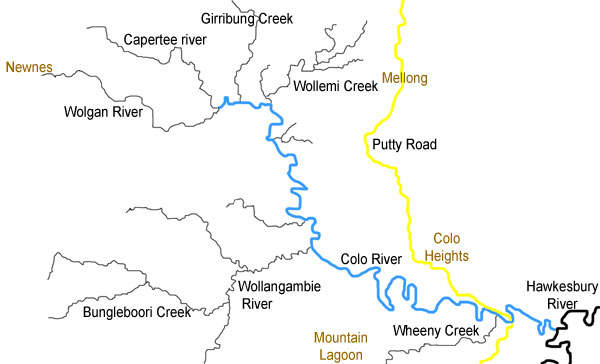Diedree Noss gave a most informative and interesting talk on the group, Friends of the Colo (FOC) at the August meeting of the North Shore District Group. The Colo River begins at the confluence of the Wolgan River and the Capertee Rivers, north of Lithgow. The river flows eastwards and then south through a deep gorge in the northern Blue Mountains and ultimately ends at the point at which it flows into the Hawkesbury River at Lower Portland. The river flows through parts of the Blue Mountains National Park which is a designated World Heritage Area.

The group began in 2000 when the primary aim was to eradicate the Black Willows (Salix nigra) from the Colo River. The group is an “adventure conservation” group going into remote areas. These areas can often only be accessed by foot (often involving steep descents to the rivers), helicopter or water. Roads in don’t exist! The duration of the field trips varies dependent on many factors but can be up to 7 days. Weather is factored into all the decisions concerning the trips. FOC achieved a 98% kill rate of Black Willows after about 5 years of work along 80km length of river. Unfortunately, Black Willows are still present on private properties further downstream, so vigilance against resurgence of the problem is required.
FOC have continued their work along the riparian zone (20 metres beside the rivers) targeting other species of weed, such as Cape Ivy (Delairea odorata), Tree of Heaven (Ailanthus altissima), Crack willow (Salix fragilis), Lantana, Gleditsia spp, Moth vine (Araujia sericifera), Tobacco bush (Solanum mauritianum), Figs and Privet spp. Many of these weeds are garden or property escapees that have been carried downstream.
All volunteers complete comprehensive training in all aspects of safety: crossing rivers, throwing ropes, using the chemicals, rescuing others and water skills. The water skills are honed at the Penrith white water facility. Safety equipment (PPE) is always used. FOC works collaboratively with NPWS, local land services and councils and complies with all the various requirements. Pesticide awareness and chemical certificates are essential as often the weed control entails their usage. People usually work in pairs to facilitate the effectiveness and speed of poison application and personal safety. The usual method is for the creation of chiselled lesions on the trunks of the target plant and the poison applied immediately.
One of the images shown included a large area smothered by Cape Ivy. When such affected areas are found, the siting is reported to NPWS. Contractors are then engaged to deal with these large and difficult areas and the area is monitored for a number of years. GPS location mapping is used. 12-20 trips are made each year, varying in length from 1- 7 days. For every trip there is a plan, job safety assessment and a comprehensive report issued. The report is shared with NPWS, local land services and other organisations connected with FOC.
Since the inception of FOC other groups doing similar adventure conservation work have started, including Wildcare Sprats in Tasmania (2007) where sea spurge (Euphorbia paralias) and marram grass (Ammophila arenaria) are the main species targeted.
Diedree is currently the president of the group and would welcome any expressions of interest from people friendsofthecolo@gmail.com.
Thank you to all the volunteers who undertake this rather challenging form of conservation. The camaraderie and enjoyment of members was obvious, as well as their commitment and dedication to the environment.
https://landcare.nsw.gov.au/groups/friends-of-the-colo/
https://landcarensw.org.au/groups/00190000010K1mLAAS/
